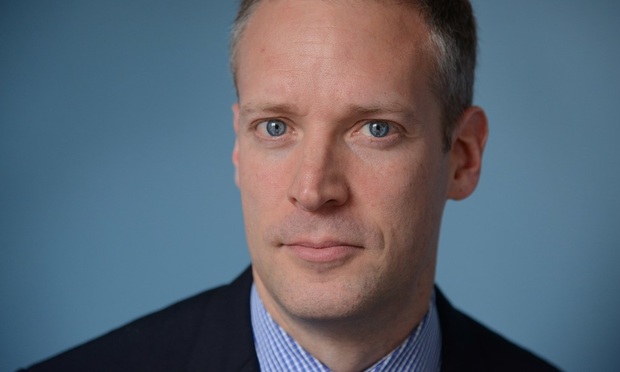Center for Court Innovation, 'Driving Force' Behind Criminal Justice Reform for Decades, Will Transition to New Leadership
During his 23 years of guiding the nonprofit, Greg Berman has watched the center grow from having 12 staffers and a $1 million budget to having 520 staffers and a $65 million budget.
October 23, 2019 at 04:55 PM
7 minute read
 Greg Berman, who spent 23 years in leadership at the Center for Court Innovation based in New York City prior to his October 2019 resignation. Photo: Rick Kopstein
Greg Berman, who spent 23 years in leadership at the Center for Court Innovation based in New York City prior to his October 2019 resignation. Photo: Rick Kopstein
When Greg Berman, who in an email to staff last week announced that he will be stepping down as head of the Center for Court Innovation, tries to pinpoint just one program or innovation that most exemplifies the organization's work, he pauses.
There have been many, and it's not easy to choose.
During his 23 years of guiding the New York City-based nonprofit—which works to both create justice system reform and build safer, healthier neighborhoods—Berman has watched the center grow from having 12 staffers and a $1 million budget to having 520 staffers and a $65 million budget.
At the same time, he has helped propel the organization—first as its deputy executive director, and for the last 18 years as executive director—from a focus in 1996 on one Midtown community court created to find more humane ways to deal with low-level Times Square-area offenders to being an international leader in justice system reform modeling that today helps to run three dozen community programs and alternative courts throughout the city and state.
Still, asked by a Law Journal reporter Tuesday to choose just one program—please—that exemplifies the center's mission and work, Berman ultimately pointed to the Red Hook Community Justice Center in southwest Brooklyn.
The Red Hook center, now in its 19th year and officially part of the state court system, adjudicates misdemeanor cases coming out of three police precincts found near a sprawling housing project. Under its state-sanctioned structure, it allows Acting Brooklyn Supreme Court Justice Alex Calabrese to avoid jailing offenders by giving him an array of sentencing alternatives—from job training programs to mental health counseling to community restitution projects, according to Berman. If necessary, the judge can and does use fines and jail time.
The results of the Red Hook center's "problem-solving" judicial work have been well-documented: Less incarceration of residents, less crime in the area, improved public attitudes towards the justice system, according to Berman.
The center was a project he helped launch back in the early 2000s, and over the years, he said, it has won national awards for its reform-oriented work, been the subject of a PBS documentary, and been visited by thousands of criminal justice officials, including international officials, who have wanted to see up close how it functions.
It's one program among many that has made Berman love his career path so far—and so when he decided recently that it was time for him to step down from his director post at the center, it wasn't easy.
"I do not make this decision lightly," he wrote in an email to staff announcing that he'd end his tenure.
"To say that I owe this agency a debt of gratitude is a serious understatement," he added. "I would literally not be who I am were it not for the Center for Court Innovation."
Still, he said, "I have come to the conclusion that I have taken the Center as far as I can," and "it is time to pass the baton to someone with the vision and the drive to take our internal infrastructure to the next level, to diversify and expand our funding base, and to advocate for our new initiatives in the marketplace of ideas."
In both his staff email and in the Law Journal interview, Berman noted that he will continue for the coming weeks as the center's executive director until a replacement is found. He also noted that Jonathan Lippman, a former New York State chief judge who helped first hire Berman into the executive director role and who has supported the center's work from early on, will lead the replacement search.
Lippman in an email Tuesday evening noted Berman's major impact on the center, as well as the reach of its innovations and reforms.
He "has made [the center] a leading voice in criminal justice in New York and beyond," said the former judge, who is now of counsel at Latham & Watkins.
Berman "is unique in his original thinking and his ability to challenge the conventional orthodoxy about crime, its causes and solutions," Lippman also said.
Today, the center gets 85% of its funding from the government, according to Berman, on the city, state and federal levels.
It works "essentially as a consulting firm," he added, providing strategic advice to various clients, including the state court system, which it has had a "special relationship with" since it opened.
Back in 1996, then-state Chief Judge Judith Kaye, coordinating with Lippman, who was then chief administrative judge, helped establish the center, deciding that, while it worked with the court system, it would be administered as a nonpartisan project of the Fund for the City of New York, according to a 2007 Law Journal article.
"We needed a vehicle to stand aside and figure out what the courts need and new ways of serving the public," Lippman said at the time.
Looking back on his 23 years at the center, Berman noted in his staff email that "when I interviewed [for the executive director position] … part of my pitch was that it was time for the center to move from the margins of the justice system and into the mainstream.
"Intellectually," he continued, "this meant legitimizing and spreading our ideas through any means we could find—books, training curricula, rigorous research, etc. Programmatically, this meant attempting to bring the strategies that we had implemented at the Midtown Community Court and Red Hook Community Justice Center of treating people humanely, offering alternatives to incarceration and fines, and engaging the community in doing justice—to the rest of the justice system in New York. "
He added, "We now employ dozens of staffers in New York City's centralized courts—resource coordinators, social workers, case managers and others—who provide judges with meaningful alternative strategies, both pretrial and post-adjudication."
He also noted in the interview Tuesday that the recent headline-grabbing actions taken by the city to close down Rikers Island's main jail came, in part, because of recommendations made by the 2017 Lippman Commission report, which was produced by an independent research commission staffed in part by the center.
"We've been a behind-the-scenes driving force helping to reduce the jail population in New York for the last generation," Berman also said, contending that "when the daily [city incarceration] head count was above 20,000, there was no space to even have a conversation about closing Rikers Island."
(Today, the head count stands at about 7,000, but must fall significantly lower in the coming years for the Rikers plan to work, according to reports.)
In between expressing his pride at the center's accomplishments and sounding somewhat wistful about stepping down, Berman also noted that it's been interesting to see how many of the criminal justice reform principles that the center has been espousing for decades have become a national issue that media and many politicians have taken up passionately.
"We've grown every year we've been alive as an institution," he said, though in the last five years, that growth has been "something beyond incremental," he said. Then in a follow-up email, he pointed out that from fiscal year 2015 to 2019, the center's budget had more than doubled, from $30 million to $65 million, and is expected to be larger next year.
"People have woken up to the enormous challenges in the criminal justice system," said Berman, "and that's the corner we've been standing on since 1996."
This content has been archived. It is available through our partners, LexisNexis® and Bloomberg Law.
To view this content, please continue to their sites.
Not a Lexis Subscriber?
Subscribe Now
Not a Bloomberg Law Subscriber?
Subscribe Now
NOT FOR REPRINT
© 2025 ALM Global, LLC, All Rights Reserved. Request academic re-use from www.copyright.com. All other uses, submit a request to [email protected]. For more information visit Asset & Logo Licensing.
You Might Like
View All
The Met Hires GC of Elite University as Next Legal Chief

New York City’s Failure To Pay Its Bills Is Putting Vulnerable New Yorkers in the Crosshairs
4 minute read
$17B Episcopal Church Pension Fund Hires New Legal Chief as Staff Changes Continue

Legal Aid Society Honors Milbank Attorney, Selendy Gay for Providing Pro Bono Firepower
2 minute readTrending Stories
Who Got The Work
J. Brugh Lower of Gibbons has entered an appearance for industrial equipment supplier Devco Corporation in a pending trademark infringement lawsuit. The suit, accusing the defendant of selling knock-off Graco products, was filed Dec. 18 in New Jersey District Court by Rivkin Radler on behalf of Graco Inc. and Graco Minnesota. The case, assigned to U.S. District Judge Zahid N. Quraishi, is 3:24-cv-11294, Graco Inc. et al v. Devco Corporation.
Who Got The Work
Rebecca Maller-Stein and Kent A. Yalowitz of Arnold & Porter Kaye Scholer have entered their appearances for Hanaco Venture Capital and its executives, Lior Prosor and David Frankel, in a pending securities lawsuit. The action, filed on Dec. 24 in New York Southern District Court by Zell, Aron & Co. on behalf of Goldeneye Advisors, accuses the defendants of negligently and fraudulently managing the plaintiff's $1 million investment. The case, assigned to U.S. District Judge Vernon S. Broderick, is 1:24-cv-09918, Goldeneye Advisors, LLC v. Hanaco Venture Capital, Ltd. et al.
Who Got The Work
Attorneys from A&O Shearman has stepped in as defense counsel for Toronto-Dominion Bank and other defendants in a pending securities class action. The suit, filed Dec. 11 in New York Southern District Court by Bleichmar Fonti & Auld, accuses the defendants of concealing the bank's 'pervasive' deficiencies in regards to its compliance with the Bank Secrecy Act and the quality of its anti-money laundering controls. The case, assigned to U.S. District Judge Arun Subramanian, is 1:24-cv-09445, Gonzalez v. The Toronto-Dominion Bank et al.
Who Got The Work
Crown Castle International, a Pennsylvania company providing shared communications infrastructure, has turned to Luke D. Wolf of Gordon Rees Scully Mansukhani to fend off a pending breach-of-contract lawsuit. The court action, filed Nov. 25 in Michigan Eastern District Court by Hooper Hathaway PC on behalf of The Town Residences LLC, accuses Crown Castle of failing to transfer approximately $30,000 in utility payments from T-Mobile in breach of a roof-top lease and assignment agreement. The case, assigned to U.S. District Judge Susan K. Declercq, is 2:24-cv-13131, The Town Residences LLC v. T-Mobile US, Inc. et al.
Who Got The Work
Wilfred P. Coronato and Daniel M. Schwartz of McCarter & English have stepped in as defense counsel to Electrolux Home Products Inc. in a pending product liability lawsuit. The court action, filed Nov. 26 in New York Eastern District Court by Poulos Lopiccolo PC and Nagel Rice LLP on behalf of David Stern, alleges that the defendant's refrigerators’ drawers and shelving repeatedly break and fall apart within months after purchase. The case, assigned to U.S. District Judge Joan M. Azrack, is 2:24-cv-08204, Stern v. Electrolux Home Products, Inc.
Featured Firms
Law Offices of Gary Martin Hays & Associates, P.C.
(470) 294-1674
Law Offices of Mark E. Salomone
(857) 444-6468
Smith & Hassler
(713) 739-1250






